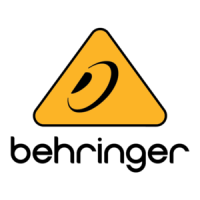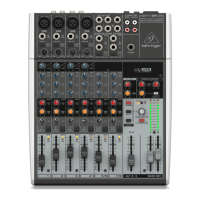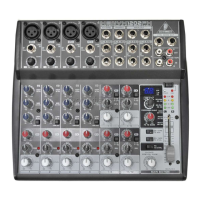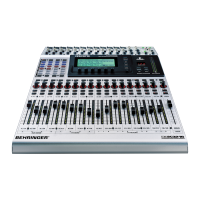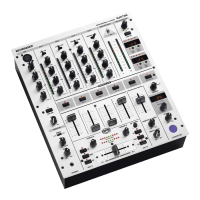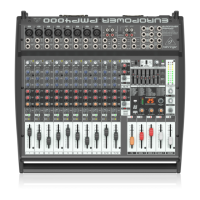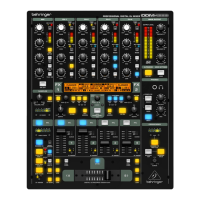13
B-CONTROL
DEEJAY
BCD3000
5.4 Signal routing
With the USB interface, you can record and play back up to four
audio signals simultaneously. The signal routing is specified by
the settings of the applied software (for example, TRAKTOR 3
LE), Control Panel and the state of the buttons on the device.
In Windows, the possibilities of signal routing depend on the
chosen driver (ASIO or WDM/MME).
5.4.1 Routing possibilities with the ASIO driver
(Windows)
STANDARD Mode:
If “STANDARD” is selected in the GLOBAL MODE of Control
Panel, only the input signals can be selected. The output
assignment is preconfigured. The software outputs 1-2 are routed
to the MASTER OUTPUT (rear panel) and the software
outputs 3-4 are routed to the PHONES output (front panel).
Usually, it is recommended to use the STANDARD mode, which
is also the case when using the TRAKTOR 3 LE software.
BCD3000
Hardware
BCD3000
Hardware
Windows Software
MIC IN
IN A (PHONO)
IN B
PHONO
LINE
MIC
PHONO A
IN A
CH 1-2
CH-3-4
MASTER OUT
PHONES OUT
CH 1-2
CH-3-4
ASIO
Windows Driver
ASIO
Windows Driver
CONTROL PANEL
Windows Software
OUT
IN
CONTROL PANEL
Abb. 5.3: Audio routing in STANDARD mode (ASIO driver)
Advanced Mode:
In Advanced mode, all parameters of the ASIO driver can be
adjusted. In Control Panel, you can select the input source for
channel IN A (CH 1-2, Mic or Phono A). The input source for IN B
(CH 3-4, Phono or Line) is selected with the PHONO/LINE switch
on the rear panel of the BCD3000. The playback channels
CH 1-2 or CH 3-4 are also selected in Control Panel for the main
outputs and the headphone output (in the MASTER
OUT and PHONES OUT fields). If you assign the software output
channels 1-2 to the headphone output, the channels 3-4 are
automatically assigned to the MASTER OUTPUT, and vice versa.
MIC IN
IN A (PHONO)
IN B
PHONO
LINE
MIC
PHONO A
CH 1-2
CH-3-4
CH 1-2
CH 3-4
CH 1-2
CH 3-4
MAST OUT
PHNS OUT
PHONES OUT
CH 1-2
CH 3-4
IN A
BCD3000
Hardware
BCD3000
Hardware
Windows Software
ASIO
Windows Driver
ASIO
Windows Driver
CONTROL PANEL
Windows Software
OUT
IN
CONTROL PANEL
MASTER OUT
Fig. 5.4: Audio routing in Advanced Mode (ASIO)
5.4.2 Routing possibilities with the WDM/MME driver
(Windows)
The WDM/MME driver supports playback/recording of 2 audio
signals. For 2-channel recording you can select input IN A or IN
B in the WDM/MME window of the control panel. When you
choose IN A, you can also determine the signal to be recorded
(Phono A or MIC).
When you select IN B, you can use the PHONE/LINE switch to
determine the signal to be recorded (phono or line).
Playback with the WDM/MME driver is always in stereo, which is
why the MASTER output and the PHONES connector of the
BCD3000 provide the same music signal.
MASTER OUTSTEREO
(CH 1-2)
PHONES OUT
MIC IN
IN A (PHONO)
IN B
PHONO
LINE
MIC
PHONO A
IN A
IN B
REC
SELECT
STEREO
(CH 1-2)
BCD3000
Hardware
BCD3000
Hardware
Windows Software
WDM/MME
Windows Driver
WDM/MME
Windows Driver
CONTROL PANEL
Windows Software
OUT
IN
CONTROL PANEL
Fig. 5.5: Audio routing with the WDM/MME driver
5.4.3 Routing possibilities (Mac OS X)
With Mac, the BCD3000 always runs in the “STANDARD” mode,
which means that only the input signals can be configured. For
channel IN A, you can assign Mic or Phono A with MIDI commands
in an appropriate software (see Table 6.7). The input source for
IN B (CH 3-4, Phono or Line) is selected with the PHONO/LINE
switch on the rear panel of the BCD3000.
The output assignment is preconfigured. The software outputs
1-2 are routed to the MASTER OUTPUT (rear panel) and the
software outputs 3-4 are routed to the PHONES output
(front panel).
MIC IN
IN A (PHONO)
IN B
PHONO
LINE
MIC
PHONO A
Prog Chg 0
Prog Chg 1
CH 1-2
CH-3-4
MASTER OUT
PHONES OUT
CH 1-2
CH-3-4
BCD3000
Hardware
BCD3000
Hardware
Mac OS X
Core Audio
Mac OS X
Core Audio
Mac OS X
OUT
IN
MIDI COMMAND
Fig. 5.6: Audio routing on the Mac
5. OPERATION
